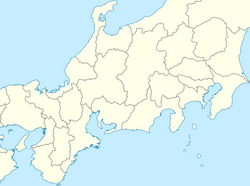1984 Nagano earthquake
  | |
| UTC time | 1984-09-13 23:48:49 |
|---|---|
| ISC event | 543747 |
| USGS-ANSS | ComCat |
| Local date | September 14, 1984 |
| Local time | 08:48 |
| Magnitude | Ms 6.3 (Mj 6.8) |
| Depth | 2 km (1 mi)[1] |
| Epicenter | 35°48′N 137°36′E / 35.8°N 137.6°ECoordinates: 35°48′N 137°36′E / 35.8°N 137.6°E [2] |
| Type | Intraplate |
| Areas affected | Japan |
| Max. intensity | Shindo 6 (estimate) |
| Peak acceleration | 0.3~ g |
| Tsunami | No |
| Landslides | Yes |
| Casualties | 14 dead 10 injured 15 missing[3] |
The 1984 Nagano earthquake (Japanese: 長野県西部地震) hit west part of Nagano Prefecture, Japan on September 14, 1984, at 08:48 local time (September 13, 1984, at 23:48 UTC). Registering a magnitude of Ms 6.3, the earthquake destroyed Otaki (Japanese: 王滝(おうたき)), and triggered major landslides.[4][5] The earthquake left at least 29 people dead or missing, making it the deadliest earthquake in 1984.
Geology[]
Although the epicenter was only 2 km (1 mi) deep, no visible fault appeared. The Japan Meteorological Agency estimated that two faults, one 15 km (9 mi) long and one 5 km (3 mi) long, had ruptured simultaneously.[1]
Relation to other earthquakes[]
Seismologists including Akeo Yoshida state that the 1948 Fukui earthquake, a 7.0 Mj earthquake in Gifu Prefecture in 1961, a 6.6 Mj earthquake in Gifu Prefecture in 1969, and this earthquake were earthquakes that occurred in a cycle for a little while in the same area.
Main Shock[]
Since there was no seismometer in the area, the Japan Meteorological Agency made an estimate intensity, Shindo 6. Some unofficial estimates put it to Shindo 7. There are reports that rocks and pieces of wood flew in the air in areas near the epicenter, due to ground accelerations faster than gravitational acceleration in the 5 Hz~10 Hz shaking range.[6] A seismometer at Makio Dam, 4 km (2 mi) away from the epicenter, observed very strong shaking but couldn't record more than 0.3 g which was the limit.
Damage[]

Due to torrential rains in the area before the earthquake, many landslides occurred.
| Total Damage | |
|---|---|
| Dead | 14 |
| Missing | 15 |
| Injured | 10 |
| Collapsed buildings | 14 |
| Half collapsed buildings | 73 |
| Damaged Buildings | 517 |
| Economic cost | US$28 million |
Incidents[]
- A massive landslide occurred on the south side of Mount Ontake, sending 3.45 million cubic meters of earth at estimated speeds of 80 to 100 km/h down the side of the mountain and buried over 3 km (2 mi) of land, including a hot spring facility, under 50 m (164 ft) of earth. A nearby valley was completely buried under 30 m (98 ft) of earth. The 4 people in the facility's owner's family and 5 people who were looking for mushrooms in the area were also buried and became missing.
- A large landslide in the Matsugoe District caused part of an inn and a road to collapse and crashed into a concrete factory on the bottom of the slope, killing 13 people working in the forest and the factory. There were no people staying at the inn, and the owner miraculously survived since she was able to stay on her tatami mat that stayed over the landslide as she was swept down. Then she was able to climb up the cliff shaped by the landslide, even though she was badly injured. She was then found and hospitalized for 2 weeks.[7]
- A house in the Takigoe District collapsed after a landslide crashed into it, killing 1 person.
- 5 people that were driving in the Kōrigase District were buried in a landslide and became missing. 2 people were able to survive by running away from the landslide.[8]
- 1 person became missing in the Yanagigase District.
- A man driving a truck was killed after being swept away by a landslide.
- A lake was formed after a landslide blocked a river.
Precursors[]
- According to Nagoya University, hot spring observatories near the epicenter recorded a big difference in the ratio of Methane and Argon, and the amount of Hydrogen before the earthquake. The change in the amount of Hydrogen is thought to be from small rupturing before the main earthquake.[9]
- A change in the percentage of Radon was observed at 141 observatories over 3 faults, including the Japan Median Tectonic Line.
Response[]
Nine check dams were built on Mount Ontake in four years after the earthquake.
See also[]
References[]
- ^ Jump up to: a b http://www2.ueda.ne.jp/~moa/ootaki.html
- ^ 日本付近のおもな被害地震年代表 - 日本地震学会
- ^ http://www.jishin.go.jp/main/yosokuchizu/chubu/p20_nagano.htm#kakojishin
- ^ "Today in Earthquake History: September 13". United States Geological Survey. December 18, 2009. Retrieved August 31, 2010.
- ^ "Archived copy". Archived from the original on 2010-09-01. Retrieved 2017-08-28.CS1 maint: archived copy as title (link)
- ^ Umeda, Yasuhiro; Kuroiso, Akio; Ito, Kiyoshi; Iio, Yoshihisa; Saeki, Tatsuo (1986). "High Accelerations in the Epicentral Area of the Western Nagano Prefecture Earthquake, 1984". Zisin (Journal of the Seismological Society of Japan). 2nd Series. 39 (2): 217–228. doi:10.4294/zisin1948.39.2_217.
- ^ "Archived copy". Archived from the original on 2009-05-29. Retrieved 2012-12-16.CS1 maint: archived copy as title (link)
- ^ "Archived copy". Archived from the original on 2004-08-22. Retrieved 2012-12-16.CS1 maint: archived copy as title (link)
- ^ Sugisaki, Ryuichi; Sugiura, Tutomu (1986). "Precursory Change in Gas Compositions at Mineral Springs and a Fumarole before the Western Nagano Prefecture Earthquake". Zisin (Journal of the Seismological Society of Japan). 2nd Series. 39: 99–109. doi:10.4294/zisin1948.39.1_99.
External links[]
- The International Seismological Centre has a bibliography and/or authoritative data for this event.
- 1984 earthquakes
- 1984 in Japan
- Landslides in Japan
- Landslides in 1984
- September 1984 events in Asia
- Earthquakes of the Showa period
